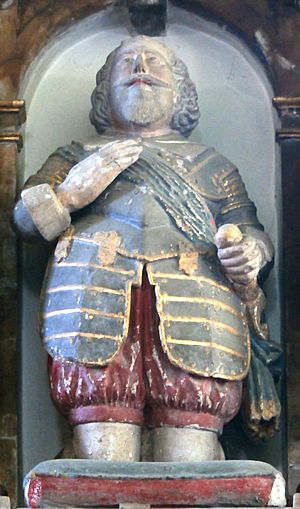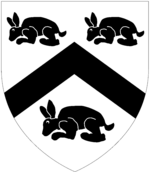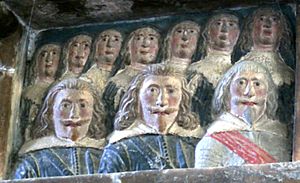William Strode (1562–1637) facts for kids
Sir William Strode (1562–1637) was an important person from Devon, England. He was part of a wealthy family that owned land. Sir William was also a military engineer, which means he helped design and build things for the army. He was elected to be a Member of Parliament seven times, representing different areas like Devon, Plympton Erle, and Plymouth. He also served as the High Sheriff of Devon and was made a knight. You can find a monument dedicated to him in the church of Plympton St Mary.
Contents
Who Was Sir William Strode?
Sir William Strode was the only son of Richard Strode and Frances Cromwell. His mother, Frances, was a first cousin to King Edward VI. This means she was related to the royal family! Her father was Gregory Cromwell, 1st Baron Cromwell, and her grandfather was Thomas Cromwell, 1st Earl of Essex, who was a very powerful minister for King Henry VIII. Frances's mother was Elizabeth Seymour, Lady Cromwell, who was the sister of Queen Jane Seymour and Edward Seymour, 1st Duke of Somerset. Edward Seymour was the uncle and protector of King Edward VI.
Sir William's Early Life and Career
In 1580, Sir William started studying law at a famous place called Inner Temple. The next year, he inherited his father's properties and land.
When the Spanish Armada tried to invade England in 1588, Sir William became a colonel. He was in charge of 100 men from the local tin-mining area of Plympton. Around 1592, he became a Justice of the Peace for Devon, which meant he helped keep law and order.
In 1593, he took over his family's tin-mining businesses. He was also chosen to be the High Sheriff of Devon for a year. This was a very important job, like being the chief law enforcement officer for the county. In 1595, he supervised the building of Plymouth fort. Sir William was also a close friend of the famous sailor Sir Francis Drake and helped manage Drake's will after he died.
Sir William's Time in Parliament
Sir William Strode was elected as a Member of Parliament for Devon in 1597. This meant he helped make laws for the country. In 1599, he became a Deputy Lieutenant, helping the Lord Lieutenant manage the county.
He was elected MP for Plympton Erle in 1601 and again in 1604. In 1606, he was made the surveyor for Devon for life. He was re-elected MP for Plympton Erle in 1614 and 1621. In 1624, he was elected MP for Devon again. His last terms as MP for Plympton Erle were in 1625 and 1626.
Where Did Sir William Live?
Besides his main home at Newnham, Sir William also had a house in Meavy, which was about six miles north. Later, his second son, William Strode (1594–1645), who also became an MP, lived there. Sir William's great-grandfather had married into a family from Meavy, so the connection to the area was long-standing.
Sir William Strode passed away in 1637. He was buried in the church of St Mary's Plympton, where his monument can still be seen.
Sir William's Family
Sir William Strode was married twice.
First Marriage
In 1581, he married Mary Southcote (who died in 1618). She was the daughter of Thomas Southcote, who was also an MP. Sir William and Mary had three sons and seven daughters:
- Sir Richard Strode (1584–1669): He was the oldest son and inherited his father's titles and lands.
- William Strode (1594–1645): He was the second son and also became an MP. He was one of the Five Members that King Charles I tried to arrest in 1642. This event helped start the Civil War.
- John Strode: The third son, who lived in Tavistock.
- Mary Strode (born 1586): The oldest daughter. She married Sir George Chudleigh, 1st Baronet of Atherington.
- Joanna Strode: The second daughter. In 1615, she married Sir Francis Drake, 1st Baronet, who was the nephew of the famous Admiral Sir Francis Drake. She later married John Trefusis in 1639.
- Ursula Strode (died 1635): The third daughter. She married Sir John III Chichester. Her monument is in Bishop's Tawton Church.
- Frances Strode: The fourth daughter. She married Sir Samuel Somaster in 1606 or 1607.
- Juliana Strode (died 1627): The fifth daughter. She married Sir John Davie, 1st Baronet. Her monument is in Sandford Church.
- Margaret Strode: The sixth daughter. She married Sir John Younge.
- Elizabeth Strode: The seventh daughter. She married Edmond Speccot.
Second Marriage
In 1624, Sir William married Dunes Glanville (who died in 1635). She was the daughter of Nicholas Glanville. This was her third marriage, and they did not have any children together.
Images for kids
Sources
- Hasler, P. W., biography of Sir William Strode published in History of Parliament: House of Commons 1558-1603, ed. P.W. Hasler, 1981
- Risdon, Tristram (died 1640), Survey of Devon. With considerable additions. London, 1811.
– pp. 718–720, pedigree of Strode
| Parliament of England (to 1707) | ||
|---|---|---|
| Preceded by Thomas Denys |
Member of Parliament for Devon 1597 |
Succeeded by William Courtenay |
| Preceded by George Southcote |
Member of Parliament for Plympton Erle 1601–1614 |
Succeeded by Sampson Hele |
| Preceded by Sampson Hele |
Member of Parliament for Plympton Erle 1621–1622 |
Succeeded by Sir Francis Drake, 1st Baronet |
| Preceded by John Drake |
Member of Parliament for Devon 1624 |
Succeeded by Francis Fulford |
| Preceded by Sir Francis Drake, 1st Baronet |
Member of Parliament for Plympton Erle 1625–1626 |
Succeeded by Thomas Hele Bt |








